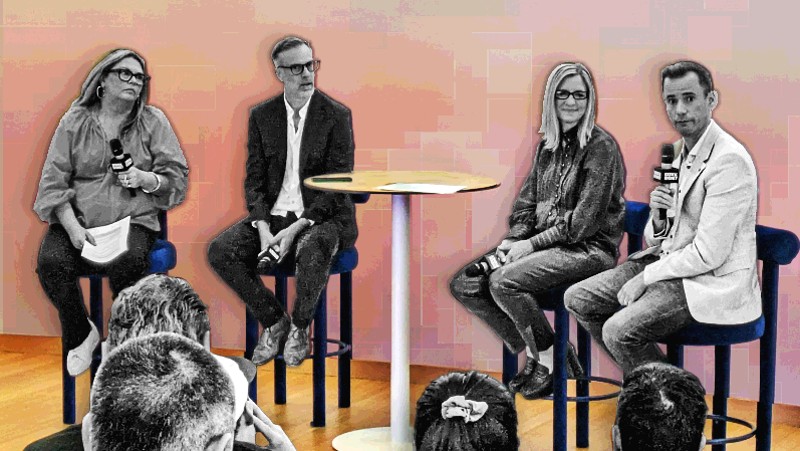Why marketers are shooting themselves in the foot with creative impatience, and how we can all better make the case for much-needed brand investment
An Mi3 editorial series brought to you by
7 / 7plus


The underinvestment in brand building in Australia is a "criminal indictment" marketers should fess up to, says Analytic Partners MD. But as a panel of marketers at SxSW Sydney demonstrated, it’s not the only problem with the way marketers are utilising insights and science in combination with the art of marketing to drive true effectiveness.
We don’t really know how long creative keeps delivering dividends for brands because marketers always kill campaigns before we have a chance of finding out.
So said a fired-up Paul Sinkinson, MD of Analytic Partners Australia, who was on a panel of marketers including Guzman y Gomez global CMO, Lara Thom, ADMA CEO, Andrea Martens, and Coles 360 head of data and intelligence, Andy Ford, at this week’s SxSW Sydney to debate what it takes to make marketing more accountable and effective.
The question of creative’s effectiveness – and whether marketers would ever be willing to hold on to the same creative for as long as it can actually perform with audiences - came amid wider criticism against the marketing profession for misconstruing the insights and failing to correctly apply the science in the broader context and expectations of the consumer.
Take attention. In discussing the creative genius behind pioneering advertising like Lion’s creative putting Lionel Richie playing piano in the fridge to promote its Tap King home beer dispenser, Thom questioned whether the same thing could be achieved today. By contrast, she suggested brands only had the first 4 seconds to grab attention given society’s widespread attention deficit.
“Have we lost that ability to put Lionel in the fridge? Are they still effective and are newer generations appreciating that art and responding to it? Or is influencer marketing just taking over and saying, ‘try this beauty cream because I look hot’?” she asked.
For Ford, short attention was certainly the case in his former gig at Meta, and it’s what he believes creatives are faced with in retail media.
“Sadly, the big reveal at the end feels a bit wasted now,” he said. “If you have someone watching the big screen however, it’s fine – you just have to have a mix of all the things to maximise gaining attention.”
But Sinkinson warned the attention static can easily be misconstrued.
“I think we’ve taken an insight and misinterpreted that one where we should have taken more science,” he said.
“Movies are longer and books are longer – why is that? People are binge watching entire TV shows. It’s just now we’re more sure of paying attention to something we want to. I don’t think the insight of ‘give people something they find interesting, so they pay attention to it’ is new, it’s just people have more choice. It’s less about attention – otherwise those books and movies would be shorter.
“It’s not that you don’t need to grab attention upfront – it’s a reflection of choice. I think where that thinking takes you though is problematic.”
In testing 50,000 campaigns in Australia, Analytic Partners found just 14 of them had worn out.
“The other 49,986 had not run out. The marketer had got bored of it before anyone else,” Sinkinson said. “It tells you the importance of creative too; it’s really important. But the insight isn’t you need to do short-term stuff, it’s that you need to give something to people that’s interesting because the pay-off is you can keep it for ages. So invest your time in doing good creative to give people that good thing. It doesn’t need to be short. It needs to get their attention and it needs to be good.”
Thom agreed, noting her former VB boss coined the maxim: “Just as you are getting sick of your creative, the consumer is just starting to get it”.
But how long can a campaign last for? And should it even go for?
“I don’t know because a marketer has always killed it before it worn out,” Sinkinson replied. “‘Just like a milkshake, only crunchy’ – that’s gone on for years. There are campaigns that have lasted for 3-4 years and are still delivering great results. In fact, they’re getting better. It’s not wear out, it’s wear in. In year two, the results are higher than in year one. It’s not how much they have dropped, it’s how much they have increased.
“Longer than you think and longer than you will let is the answer.”
Martens partly attributed the issue to marketers getting confused between creative strategy and thought and campaign idea, then execution of it.
“Brilliance of thought can very well go beyond one single execution. If the insight is right and you have a proposition that’s relevant for that, bring it to life,” she said. “If it needs to be tweaked, then tweak it. But don’t throw the whole insight or creative platform out.”
Panellists agreed the other contextual element relevant to creative effectiveness is ensuring the creative platform extends across all executions but is fit-for-purpose by channel.
“It needs to be relevant for each part – that’s probably the key insight,” Sinkinson added. “Before you get the 60-second TVC script… it’s that idea of how it’s being expressed as a 15, 30, 10, 3 and static. It might mean the longform ad isn’t as great, but it makes everything else better.
“We still see TVCs online. But as soon as you make it fit for channel, with tighter frame shots, action happening faster, branding in the first 3 seconds and humans in vision, you can see a 300 per cent increase in ROI.
“How many times do you see an out-of-home ad and it’s the in-frame TVC with pack shot? Dear God. people will say well, it’s not really an art kind of channel. Tell Da Vinci or look at the Sistine Chapel – people used to do out-of-home art pretty well.”
We’re so underinvested, we’re one of the few markets where the ROI of brand activity is massive. Think about it: If you’re spending so little, you’re on the steep part of the yield curve where it’s amazing. That’s a criminal indictment. The ROI should be low because it needs long term to pay off
Australia’s woeful brand building investments
A related issue here is brand investment itself. Further in the session, Sinkinson took aim at marketers for failing to invest adequately in brand building in this country.
“We are so underinvested in Australia in long-term brand building and overinvested in short-term brand activity. We are overinvesting in short-term activity,” he declared.
“We’re so underinvested, we’re one of the few markets where the ROI of brand activity is massive. Think about it: If you’re spending so little, you’re on the steep part of the yield curve where it’s amazing. That’s a criminal indictment. The ROI should be low because it needs long term to pay off.”
Yet as the majority of marketers will attest, upholding brand investment and proving its effectiveness against a short-term digital performance hit remains fraught with difficulty. While Thom was more dismissive of brand tracking, and Sinkinson dismissive of brand love as directly correlating to conversion, Martens made the case for more effort being put into positioning brand awareness and strategy in the c-suite as well as leveraging the full four Ps of marketing.
“There is something around how we as marketers measure the brand salience and explaining that to the CFO and CEO around how it translates,” she said. “Understanding as a brand what the awareness number is, but also where issues are in the funnel, our conversion rates, the challenges versus competitors and key drivers of those challenges. So instead of going in just on a brand awareness problem, it’s a consideration issue and it’s drive by X, Y and Z. The levers to this may well be price, they be proposition, or something else.
“It’s about that level of understanding, that level of data, being able to pull that apart as a market at a minimum, once a year if not more regularly is fundamental to those underlying strategic pieces. How can you find where you’re going as a brand and what you need to unlock if you don’t have that insight? Otherwise, you’re just basing it on your last tactic, which is your last ad. Really, is that what brand is made of? No, it’s much more than that.”
